This post may contain affiliate links. Please read our disclosure policy.
Soft and spongy Chinese steamed egg cake with sweet mung bean paste in between each cake layer. It’s a light cake that is perfect for breakfast or tea time.

This cake takes inspiration from the classic genoise sponge cake but instead of baking it, the cake is steamed instead. It’s actually also pretty similar to the Chinese traditional steamed egg cake (ji dan gao). The cake is then layered with sweet mung bean paste in between. It’s a light cake, yet enough to satisfy that craving for something a little sweet but not overly!
Ingredients and substitutions
1. Cake flour
I don’t recommend using all-purpose flour (medium gluten content). If you do, just know that the crumb won’t be as soft and fluffy
2. Cocoa powder
You can use regular cocoa powder or Dutch-processed cocoa powder
3. Baking powder
Make sure it is still fresh. Do not substitute with baking soda. They are not the same thing and cannot be substituted in the same amount
4. Eggs
I usually use large eggs that weigh about 58-60 grams with the shell
5. Sugar
I use granulated sugar. Feel free to use caster sugar. Please do not substitute with powdered sugar
6. Oil
Any neutral-tasting cooking oil works here
7. Salt
A tiny pinch of fine sea salt is all you need

How to make a steamed layer sponge cake with mung bean paste
1. You can use store-bought sweet mung bean paste or make some with this sweet mung bean paste recipe. I use a 8 x 3 inch round cake pan. Line the round cake pan with parchment paper all around. It’s okay to have some extra on the sides as you can fold it down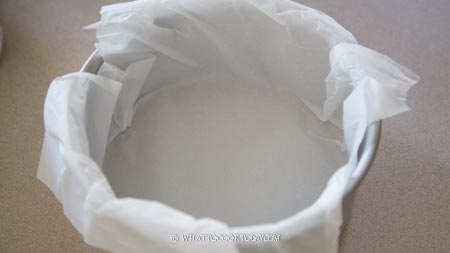
2. Combine cake flour, salt, baking powder, and cocoa powder in a bowl. Set aside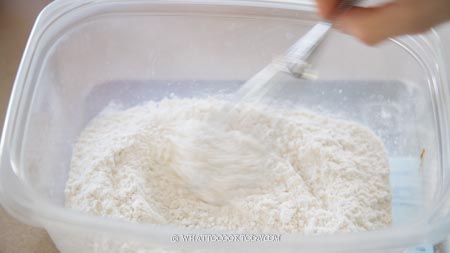
3. Crack eggs into a mixing bowl. Beat over high speed (speed 8 on Kitchen Aid) for about 1 minute. Then gradually add in sugar in 3-4 batches. Continue to beat until the mixture is pale and creamy, about 10 minutes with a stand mixer on high speed (speed 8 on Kitchen Aid), about 15-20 minutes with a hand mixer. The volume would have tripled by now. The mixture will be thick and you can write figure 8 and it won’t disappear immediately. We call this “ribbon stage”. It is important to reach a ribbon stage or your cake will be dense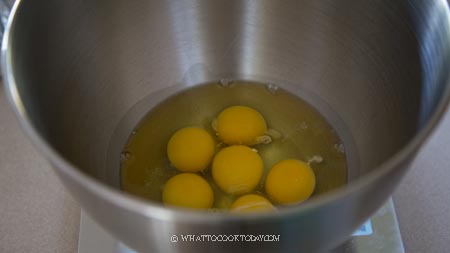
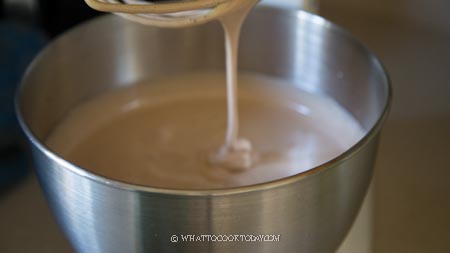
4. Stop the mixer. Crank the heat on the stove back up so the steamer is ready. Add in the cake flour mixture in 3 batches, alternating with the oil in batches. Use a whisk to gently swipe and fold over flour and oil. Just mix until you no longer see pockets of the flour mixture. Switch to a spatula to make sure everything is properly combined. Don’t overmix either or your cake will be dense and tough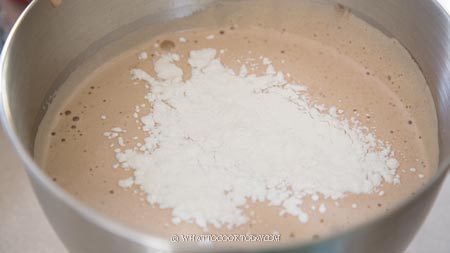
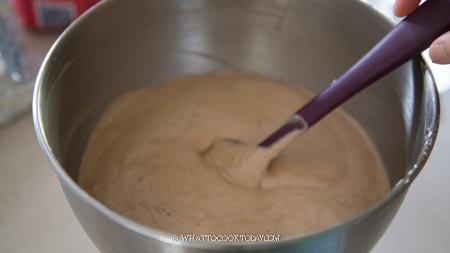
5. If you want to make a 2-layer cake, pour 1/2 of the cake batter into a prepared pan. Drop the pan on a counter a few times to pop and large bubbles. If you plan to make 3-layer cake, pour 1/3 of the cake batter. I suggest not making more than 3 layer as the cake batter has to sit out for too long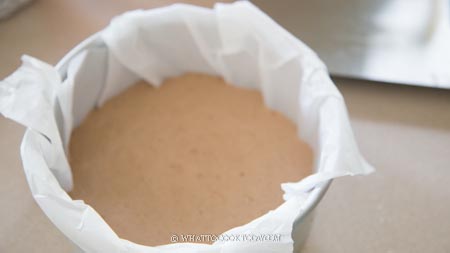
6. Put the pan inside the steamer. Wrap the lid with a towel to prevent condensation from dripping on the surface of the cake. Steam over high heat for 10 minutes.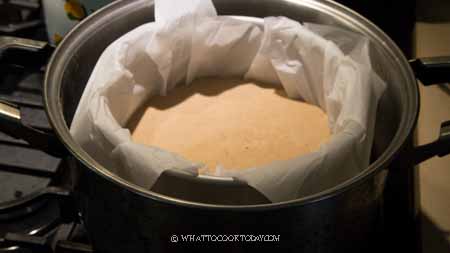
7. While the cake is steaming, divide the mung bean paste into 2 portions, 150 g each for a 3-layer cake. For a 2-layer cake, you don’t need to divide. Roll each one in between two parchment papers into a round circle, about the same size as the pan. They don’t have to be perfectly round, just do your best. You will have 1 circle if you do 2-layer cake and 2 circles if you do a 3-layer cake.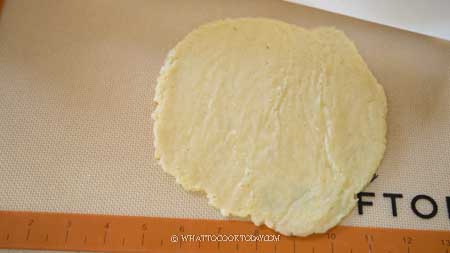
8. Back to the cake: Uncover the lid and check on the cake. The surface should be dry to touch and bounce back when you gently press on it. Remove from the steamer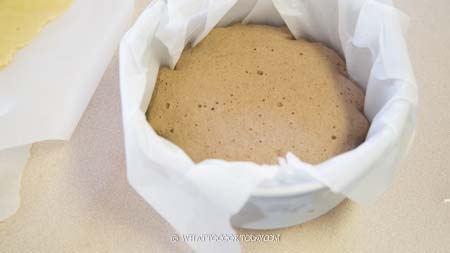
9. Drape one of the mung bean paste round on top of the steamed cake. Use a rubber spatula to make it neat and spread out as evenly as possible.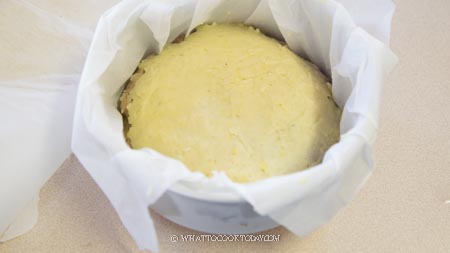
10. Carefully pour in the next 1/2 or 1/3 of the batter on top of the mung bean layer. Give the pan a few taps on the counter to pop any large bubbles. Put the pan back into the steamer and steam again on high heat for 10 minutes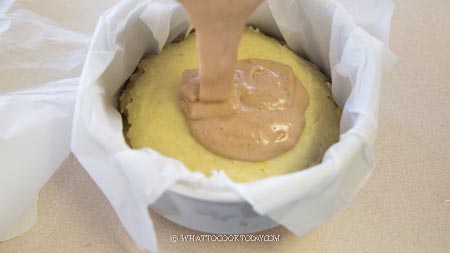
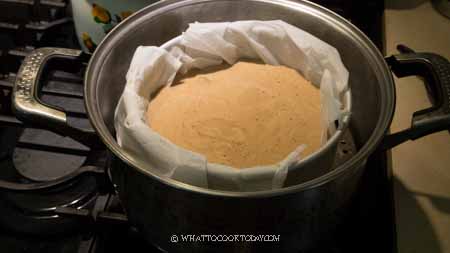
11. If you do a 3-layer cake, repeat this sequence again by draping the next mung bean paste round on top of the steamed cake, then pour the last 1/3 of the batter on top. Give the pan a few taps to pop the bubbles and then steam over high heat for 20 minutes. The surface of the cake should be dry to touch and bounce back when you press on it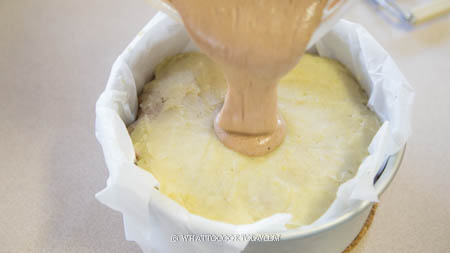
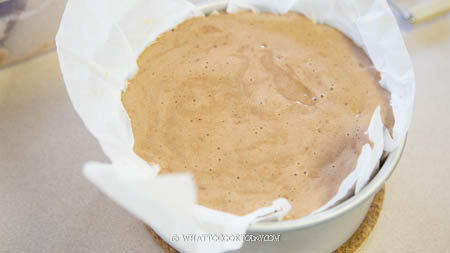
12. Check the water level when you remove the cake from the steamer. Fill it up with hot water if needed and bring it back to a boil over high heat.
13. When the cake is done, remove it from the steamer and leave the cake out of the pan by lifting the parchment paper and letting it cool down on a cooling rack. This way the bottom of the cake won’t be wet and soggy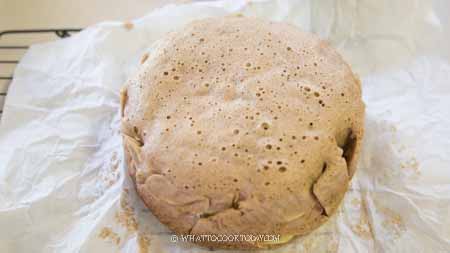

Did you make this steamed layer sponge cake with mung bean paste recipe?
I love it when you guys snap a photo and tag it to show me what you’ve made. Simply tag me @WhatToCookToday #WhatToCookToday on Instagram and I’ll be sure to stop by and take a peek for real!

Steamed Layer Sponge Cake with Mung Bean Paste
Ingredients
For the cake batter:
- 165 g cake flour
- 1 Tbsp cocoa powder
- 1 tsp baking powder
- ⅛ tsp salt
- 300 g eggs (room temperature) about 6 large eggs
- 150 g sugar
- 40 g oil
For mung bean paste layer:
- 300 g mung bean paste
Instructions
- I use a 8 x 3 inch round cake pan. Line the round cake pan with parchment paper all around. It's okay to have some extra on the sides as you can fold it down
- Fill up the steamer with water, enough to steam for at least the first 30 minutes. Bring it to a boil and then lower to medium to keep it on a stand-by
For the cake batter:
- Combine cake flour, salt, baking powder, and cocoa powder in a bowl. Set aside
- Crack eggs into a mixing bowl. Beat over high speed (speed 8 on Kitchen Aid) for about 1 minute. Then gradually add in sugar in 3-4 batches. Continue to beat until the mixture is pale and creamy, about 10 minutes with a stand mixer on high speed (speed 8 on Kitchen Aid), about 15-20 minutes with a hand mixer. The volume would have tripled by now. The mixture will be thick and you can write figure 8 and it won't disappear immediately. We call this "ribbon stage". It is important to reach a ribbon stage or your cake will be dense
- Stop the mixer. Crank the heat on the stove back up so the steamer is ready. Add in cake flour mixture in 3 batches, alternating with the oil in batches. Use a whisk to gently swipe and fold over flour and oil. Just mix until you no longer see pockets of the flour mixture. Switch to spatula to make sure everything is properly combined. Don't overmix either or your cake will be dense and tough
- If you want to make a 2-layer cake, pour 1/2 of the cake batter into a prepared pan. Drop the pan on a counter a few times to pop and large bubbles. If you plan to make 3-layer cake, pour 1/3 of the cake batter. I suggest not making more than 3 layer as the cake batter has to sit out for too long. Drop the pan on a counter a few times to pop any large bubbles
Steaming:
- Put the pan inside the steamer. Wrap the lid with a towel to prevent condensation from dripping on the surface of the cake. Steam over high heat for 10 minutes.
- While the cake is steaming, divide the mung bean paste into 2 portions, 150 g each for a 3-layer cake. For a 2-layer cake, you don't need to divide. Roll each one in between two parchment papers into a round circle, about the same size as the pan. They don't have to be perfectly round, just do your best. You will have 1 circle if you do 2-layer cake and 2 circles if you do a 3-layer cake.
- Back to the cake: Uncover the lid and check on the cake. The surface should be dry to touch and bounce back when you gently press on it. Remove from the steamer
- Drape one of the mung bean paste round on top of the steamed cake. Use a rubber spatula to make it neat and spread out as evenly as possible.
- Carefully pour in the next 1/3 of the batter on top of the mung bean layer. Give the pan a few taps on the counter to pop any large bubbles. Put the pan back into the steamer and steam again on high heat for 10 minutes
- Check on the water level when you remove the cake from the steamer. Fill it up with hot water if needed and bring it back to a boil over high heat.
- Repeat this sequence again by draping the next mung bean paste round on top of the steamed cake, then pour the last 1/3 of the batter on top. Give the pan a few taps to pop the bubbles and then steam over high heat for 20 minutes. The surface of the cake should be dry to touch and bounce back when you press on it
Cooling:
- When the cake is done, remove it from the steamer and leave the cake out of the pan by lifting the parchment paper and letting it cool down on a cooling rack. This way the bottom of the cake won't be wet and soggy
- Let the cake cool down completely before slicing




